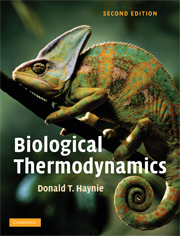Book contents
- Frontmatter
- Contents
- Preface to the second edition
- Chapter 1 Energy transformation
- Chapter 2 The First Law of Thermodynamics
- Chapter 3 The Second Law of Thermodynamics
- Chapter 4 Gibbs free energy – theory
- Chapter 5 Gibbs free energy – applications
- Chapter 6 Statistical thermodynamics
- Chapter 7 Binding equilibria
- Chapter 8 Reaction kinetics
- Chapter 9 The frontier of biological thermodynamics
- Appendices
- Glossary
- Index of names
- Subject index
- References
Preface to the second edition
Published online by Cambridge University Press: 05 June 2012
- Frontmatter
- Contents
- Preface to the second edition
- Chapter 1 Energy transformation
- Chapter 2 The First Law of Thermodynamics
- Chapter 3 The Second Law of Thermodynamics
- Chapter 4 Gibbs free energy – theory
- Chapter 5 Gibbs free energy – applications
- Chapter 6 Statistical thermodynamics
- Chapter 7 Binding equilibria
- Chapter 8 Reaction kinetics
- Chapter 9 The frontier of biological thermodynamics
- Appendices
- Glossary
- Index of names
- Subject index
- References
Summary
Interest in the biological sciences has never been greater. Today, biology, biochemistry, biophysics, and bioengineering are engaging the minds of young people in the way that physics and chemistry did thirty, forty, and fifty years ago. There has been a massive shift in public opinion and in the allocation of resources for university-based research. Breakthroughs in genetics, cell biology, and medicine are transforming the way we live, from improving the quality of produce to eradicating disease; they are also stimulating pointed thinking about the origin and meaning of life. Growing awareness of the geometry of life, on length scales extending from an individual organism to a structural element of an individual macromolecule, has led to a reassessment of the principles of design in all the engineering disciplines, including computation. And a few decades after the first determination at atomic resolution of the structures of double-stranded DNA and proteins, it is becoming increasingly apparent that both thermodynamic and structural information are needed to gain a deep sense of the functional properties of biological macromolecules. Proteins, nature's own nanoscale machines, are providing inspiration for innovative and controlled manipulation of matter at the atomic scale.
This book is about the thermodynamics of living organisms. It was written primarily for undergraduate university students; mostly students of the biological sciences, but really for students of any area in science, engineering, or medicine.
- Type
- Chapter
- Information
- Biological Thermodynamics , pp. xi - xviPublisher: Cambridge University PressPrint publication year: 2008

